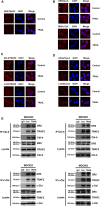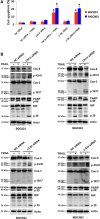DR5-Cbl-b/c-Cbl-TRAF2 complex inhibits TRAIL-induced apoptosis by promoting TRAF2-mediated polyubiquitination of caspase-8 in gastric cancer cells
- PMID: 28972304
- PMCID: PMC5709619
- DOI: 10.1002/1878-0261.12140
DR5-Cbl-b/c-Cbl-TRAF2 complex inhibits TRAIL-induced apoptosis by promoting TRAF2-mediated polyubiquitination of caspase-8 in gastric cancer cells
Abstract
Ubiquitination of caspase-8 regulates TNF-related apoptosis-inducing ligand (TRAIL) sensitivity in cancer cells, and the preligand assembly complex plays a role in caspase-8 polyubiquitination. However, whether such a complex exists in gastric cancer cells and its role in TRAIL-triggered apoptosis is unclear. In this study, DR5, casitas B-lineage lymphoma-b (Cbl-b)/c-Cbl, and TRAF2 formed a complex in TRAIL-resistant gastric cancer cells, and Cbl-b and c-Cbl were the critical adaptors linking DR5 and TRAF2. Treatment with TRAIL induced caspase-8 translocation into the DR5-Cbl-b/c-Cbl-TRAF2 complex to interact with TRAF2, which then mediated the K48-linked polyubiquitination of caspase-8. The proteasome inhibitor bortezomib markedly enriched the p43/41 products of caspase-8 activated by TRAIL, indicating proteasomal degradation of caspase-8. Moreover, TRAF2 knockdown prevented the polyubiquitination of caspase-8 and thus increased TRAIL sensitivity. In addition, the inhibition of Cbl-b or c-Cbl expression and overexpression of miR-141 targeting Cbl-b and c-Cbl partially reversed TRAIL resistance by inhibiting the interaction between TRAF2 and caspase-8 and the subsequent polyubiquitination of caspase-8. These results indicate that the DR5-Cbl-b/c-Cbl-TRAF2 complex inhibited TRAIL-induced apoptosis by promoting TRAF2-mediated polyubiquitination of caspase-8 in gastric cancer cells.
Keywords: TRAIL; Cbl-b; TRAF2; apoptosis; c-Cbl; caspase-8.
© 2017 The Authors. Published by FEBS Press and John Wiley & Sons Ltd.
Figures










Similar articles
-
Down-regulation of Cbl-b by bufalin results in up-regulation of DR4/DR5 and sensitization of TRAIL-induced apoptosis in breast cancer cells.J Cancer Res Clin Oncol. 2012 Aug;138(8):1279-89. doi: 10.1007/s00432-012-1204-4. Epub 2012 Mar 24. J Cancer Res Clin Oncol. 2012. PMID: 22447040 Free PMC article.
-
DR5 suppression induces sphingosine-1-phosphate-dependent TRAF2 polyubiquitination, leading to activation of JNK/AP-1 and promotion of cancer cell invasion.Cell Commun Signal. 2017 May 8;15(1):18. doi: 10.1186/s12964-017-0174-1. Cell Commun Signal. 2017. PMID: 28482915 Free PMC article.
-
TRAIL-activated EGFR by Cbl-b-regulated EGFR redistribution in lipid rafts antagonises TRAIL-induced apoptosis in gastric cancer cells.Eur J Cancer. 2012 Nov;48(17):3288-99. doi: 10.1016/j.ejca.2012.03.005. Epub 2012 Mar 27. Eur J Cancer. 2012. PMID: 22456178
-
TRAIL mediated signaling in pancreatic cancer.Asian Pac J Cancer Prev. 2014;15(15):5977-82. doi: 10.7314/apjcp.2014.15.15.5977. Asian Pac J Cancer Prev. 2014. PMID: 25124560 Review.
-
Ubiquitin ligase Cbl-b and inhibitory Cblin peptides.Biochim Biophys Acta Proteins Proteom. 2020 Nov;1868(11):140495. doi: 10.1016/j.bbapap.2020.140495. Epub 2020 Jul 12. Biochim Biophys Acta Proteins Proteom. 2020. PMID: 32663526 Review.
Cited by
-
TNF Receptor Associated Factor 2 (TRAF2) Signaling in Cancer.Cancers (Basel). 2022 Aug 22;14(16):4055. doi: 10.3390/cancers14164055. Cancers (Basel). 2022. PMID: 36011046 Free PMC article. Review.
-
The role of CBL family ubiquitin ligases in cancer progression and therapeutic strategies.Front Pharmacol. 2024 Jul 26;15:1432545. doi: 10.3389/fphar.2024.1432545. eCollection 2024. Front Pharmacol. 2024. PMID: 39130630 Free PMC article. Review.
-
E3 ubiquitin ligases and deubiquitinases as modulators of TRAIL-mediated extrinsic apoptotic signaling pathway.BMB Rep. 2019 Feb;52(2):119-126. doi: 10.5483/BMBRep.2019.52.2.011. BMB Rep. 2019. PMID: 30638181 Free PMC article. Review.
-
The Role of Post-Translational Modifications in Necroptosis.Biomolecules. 2025 Apr 9;15(4):549. doi: 10.3390/biom15040549. Biomolecules. 2025. PMID: 40305291 Free PMC article. Review.
-
Caspase-8: Arbitrating Life and Death in the Innate Immune System.Cells. 2025 Feb 7;14(4):240. doi: 10.3390/cells14040240. Cells. 2025. PMID: 39996713 Free PMC article. Review.
References
-
- De Miguel D, Gallego‐Lleyda A, Anel A and Martinez‐Lostao L (2015) Liposome‐bound TRAIL induces superior DR5 clustering and enhanced DISC recruitment in histiocytic lymphoma U937 cells. Leuk Res 39, 657–666. - PubMed
-
- Dong B, Lv G, Wang Q, Wei F, Bellail AC, Hao C and Wang G (2012) Targeting A20 enhances TRAIL‐induced apoptosis in hepatocellular carcinoma cells. Biochem Biophys Res Commun 418, 433–438. - PubMed
MeSH terms
Substances
Associated data
LinkOut - more resources
Full Text Sources
Other Literature Sources
Medical
Miscellaneous

